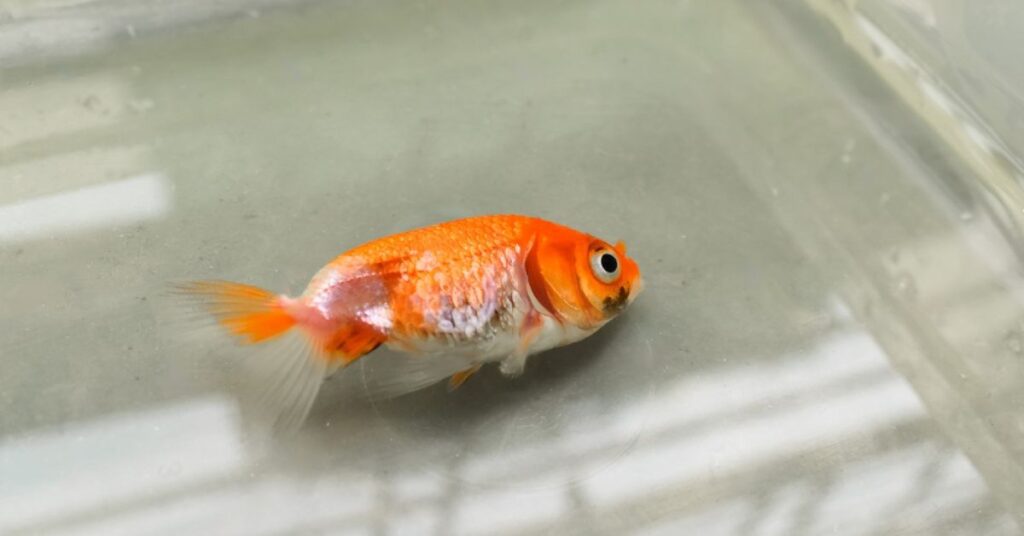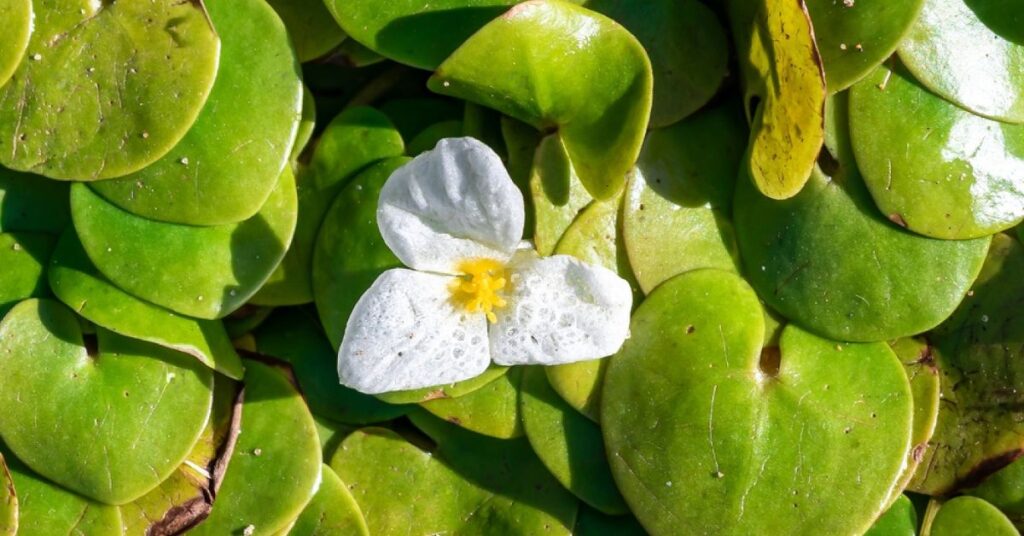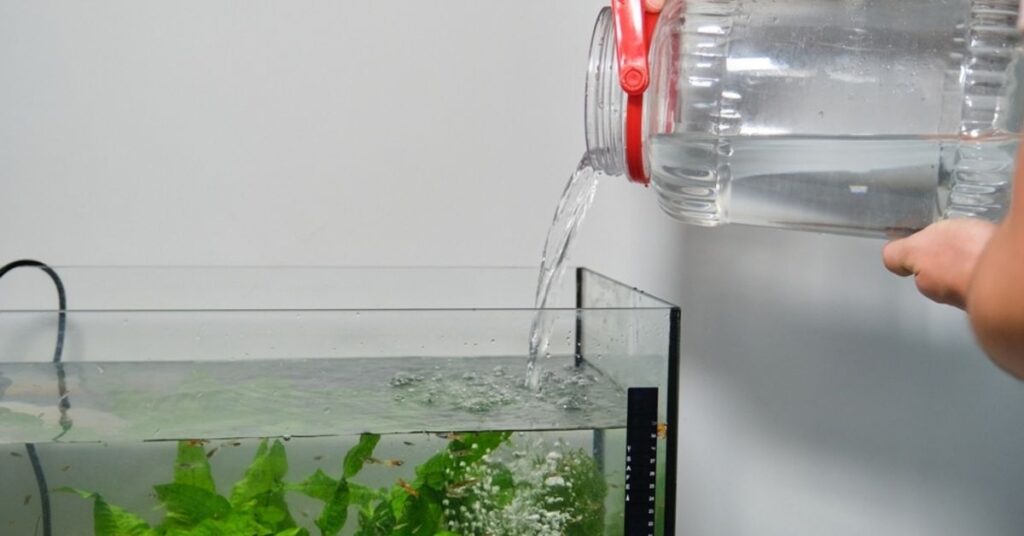Goldfish are susceptible to a condition known as nitrate poisoning if the concentration of nitrate in the water is allowed to rise to unsafe levels. We will discuss “How to Treat Nitrate Poisoning in Goldfish” in this detailed post. Removing the goldfish from the contaminated water, providing the appropriate nutrition and supplementation, increasing the oxygenation in the aquarium, and doing regular partial water changes are some of the efficient strategies that can be applied to Nitrate toxicity in goldfish.
As responsible goldfish owners, you must have a solid understanding of the factors that might lead to nitrate poisoning, as well as its symptoms and, most importantly, the remedies for dealing with high nitrate levels in goldfish tanks
I will be showing you how to treat nitrate poisoning in goldfish – step by step in this guide.
Let’s get even further into depth!
What is Nitrate Poisoning in Goldfish?
Nitrate poisoning happens when nitrate levels in the aquarium water reach dangerously high for the inhabitants.
Nitrate is a byproduct of the nitrogen cycle in fish tanks due to the breakdown of waste, uneaten food, and decomposing organic materials.
Nitrate can be measured as the concentration of nitrate in the water. Although at smaller amounts, nitrate does not pose a threat to goldfish, at higher concentrations, it can have a negative impact on their health.
Methemoglobinemia is a condition that high nitrate levels in goldfish can cause. This condition occurs when the iron atoms in hemoglobin are oxidized, which in turn reduces the flow of oxygen to the bloodstream and the tissue of the goldfish, which can result in the death of the goldfish

Signs and Symptoms of nitrate poisoning in goldfish
Toxic nitrate levels can cause a wide range of symptoms in goldfish, which might change depending on how severe the poisoning is.
The following are examples of some common symptoms:
- Lethargy and loss of appetite.
- Breathing problems.
- Gill damage.
- Erratic swimming patterns or difficulty swimming.
- Excessive mucus production.
- Darkening or discoloration of the skin.
- Ulcerations or sores on the fish’s body.
- Swollen eyes
- Bloating
- Sudden deaths in the aquarium.
Common Causes of Nitrate Poisoning
Several factors can contribute to goldfish suffering from nitrate toxicity. Understanding these causes will help you prevent the disease and keep your fish in a healthy environment:
- Overstocking the aquarium with too many goldfish.
- Overfeeding and excess accumulation of uneaten food.
- Poor filtration or not using a filter.
- Not changing the water frequently enough
- Presence of decaying plants or organic matter in the tank.
- Using live plants that produce nitrates
- Using tap water that contains high levels of nitrates
- Inefficient or insufficient biological filtration.

Treatment of nitrate poisoning in goldfish (Step by step methods)
Immediate action is required to save your goldfish if they become poisoned by nitrate.
To efficiently treat nitrate poisoning and restore your fish’s health, the following step-by-step instruction is what you should follow:
STEP ONE. Taking Goldfish Out of Contaminated Water
The first action to take is to remove the sick goldfish from the water that has been contaminated.
Make ready a separate quarantine tank or bucket, fill it with water that has been filtered and dechlorinated, and bring it to the same temperature as the main tank.
Using a container or net, carefully move the sick fish to the quarantine tank as quickly as possible while causing them as little stress.
STEP TWO. Making Changes to the Nitrate Concentrations in the Aquarium
It is necessary to lower the nitrate levels in the main tank to get to the root of what’s causing the nitrate poisoning in the first place.
The following are some nitrate removal techniques for goldfish tanks.
- Change 30 to 50 percent of the water in the container using a low nitrate concentration.
- Add a salt treatment to the water to help the fish’s gills function properly.
- Consider making use of a nitrate remover or water conditioner that has been created specially to lower nitrate levels.
- Increasing the number of helpful bacteria that are present in the tank can make the biological filtering process more effective.
- To minimize the accumulation of more nitrate, you should remove any food that is left over.
STEP THREE: Providing Appropriate Nutritional Support
Recovery from nitrate toxicity in goldfish can be greatly aided by providing them with the appropriate nutrients.
Provide a diet that is rich in variety by including high-quality flakes, pellets, as well as live food. In addition, consider using supplements that are abundant in vitamins and minerals to boost the immune system of your goldfish and improve its overall health.
STEP FOUR: Keep the fish in a warm, well-oxygenated environment
Nitrate poisoning in goldfish aquariums can result in decreased oxygen levels in the water, which can be quite stressful for goldfish. Improve the level of oxygenation by
- Installing an air pump or air stone to improve water circulation and aeration.
- Putting live plants in the aquarium so that the fish can benefit from the oxygen they produce during photosynthesis.
- Avoid overcrowding the tank so there is enough oxygen for all the fish.
STEP FIVE: Checking water parameters regularly
You must keep the water suitable for your goldfish to get better. Check the water’s ammonia, nitrite, and nitrate amounts to ensure they stay the right amount. Adjust factors as needed to keep your goldfish in a healthy setting.
STEP SIX: Conducting Partial Water Changes
Managing nitrate levels in goldfish tanks to prevent the nitrate levels from once again reaching unsafe levels, perform routine partial water changes. Your objective should be a weekly water change of 30 and 50 percent using dechlorinated water. This helps to dilute any stored nitrates, thereby preventing nitrate poisoning in goldfish.
Prevention of nitrate poisoning in goldfish
Best practices for preventing nitrate poisoning in goldfish are the most effective strategy to protect goldfish from becoming sick from nitrate poisoning.

The following are some tips for protecting against nitrate toxicity in goldfish
Overfilling the tank: Don’t fill it up too much. The size of the tank and the type of fish will determine how many fish you can keep in it.
Not changing out the water regularly: At least once a week, you should change the water in the tank.
Not using a filter: You can help get rid of nitrates in the water by using a filter.
Using live plants that produce nitrates: Don’t use living plants that make nitrates.
Too much food: Don’t give the fish too much food. Giving the fish as much food as possible in a few minutes would be best.
Using high-nitrate tap water: Use bottled or tap water cleaned to eliminate nitrates.
Grow Plants That Use Large Amounts of Nitrate: Some aquarium plants, including duckweed, are able to remove significant quantities of nitrate from the water and function effectively as natural filters for the chemical compound.

Nitrite Level for Goldfish
The amount of nitrite in a goldfish aquarium is an important thing to keep an eye on. Nitrite (NO2-) is a result of the nitrogen cycle. If there is a lot of it, it can kill goldfish.
A goldfish tank’s ideal amount of nitrite is 0 parts per million (ppm). Any amount of nitrite that can be found means that good bacteria haven’t finished turning ammonia into less dangerous substances.
Nitrite poisoning can happen when there are too many nitrites in the water. This can hurt goldfish and make them sick.
Nitrite levels must be checked regularly to make sure they stay in a safe range. If nitrite is found, Effective methods to treat nitrate poisoning in goldfish should be taken.
Some ways to do this include partial water changes, improving filtering and aeration, and monitoring ammonia levels to stop more nitrite from building up.
To keep goldfish in a healthy setting, it is vital to set up and take care of a biological filtration system. This will help turn dangerous chemicals like ammonia and nitrite into nitrate (NO3-), which is less dangerous.
Nitrites can also build up in the tank if you don’t care for it properly.
For example, you should feed your fish correctly, change the water in the tank often, and remove any food or waste that hasn’t been eaten.
Frequently Asked Questions (FAQs)
Q. Can goldfish die from nitrate poisoning?
A. Yes, nitrate poisoning can be deadly if it isn’t treated or if the amount of nitrate in the body is very high. To save the life of your goldfish, you need to move quickly.
Q. How long does it take to treat goldfish poisoned by nitrates?
A. The time it takes for a goldfish to get better after being poisoned by nitrate depends on how bad the poisoning is and how well the treatment works. Getting better could take the fish anywhere from a few days to weeks.
Q. Is nitrate poisoning contagious to other fish in the aquarium?
A. No, Nitrate poisoning is not contagious to the other fish in the tank, so don’t worry about spreading it around. Nitrate poisoning is brought on by abundant nitrates in the water; however, nitrates cannot be passed from one fish to another.
On the other hand, if one of the fish in the tank is afflicted with nitrate poisoning, it might cause the other fish in the tank to experience stress, making them more prone to contracting other ailments. As a result, it is essential to provide prompt treatment for nitrate poisoning in any fish that may be affected within the tank to stop the disease from spreading.
Q. Can a fish survive nitrate poisoning?
A. Yes, a fish can survive being poisoned by nitrates if it has been treated quickly. The severity of the poisoning will depend on how much nitrates were in the water and how long the fish was around them.
CONCLUSION
Goldfish are susceptible to nitrate poisoning, which poses a significant risk to their health and well-being. You can save your fish from this potentially lethal illness by understanding how to treat nitrate poisoning in goldfish and the causes, symptoms, and effective preventative techniques associated with the ailment.
Remember that appropriate water conditions should be maintained, proper nourishment should be provided, and immediate treatment should be taken if nitrate poisoning develops.
Your goldfish can flourish in a setting that is both safe and healthy if they are given the proper goldfish nitrate poisoning care.
If you find this guide, “How to Treat Nitrate Poisoning in Goldfish.” Helpful, Please subscribe to our newsletter below for the latest content.
Related Post: 25 Popular Types Of Goldfish (For Beginners with photos)

